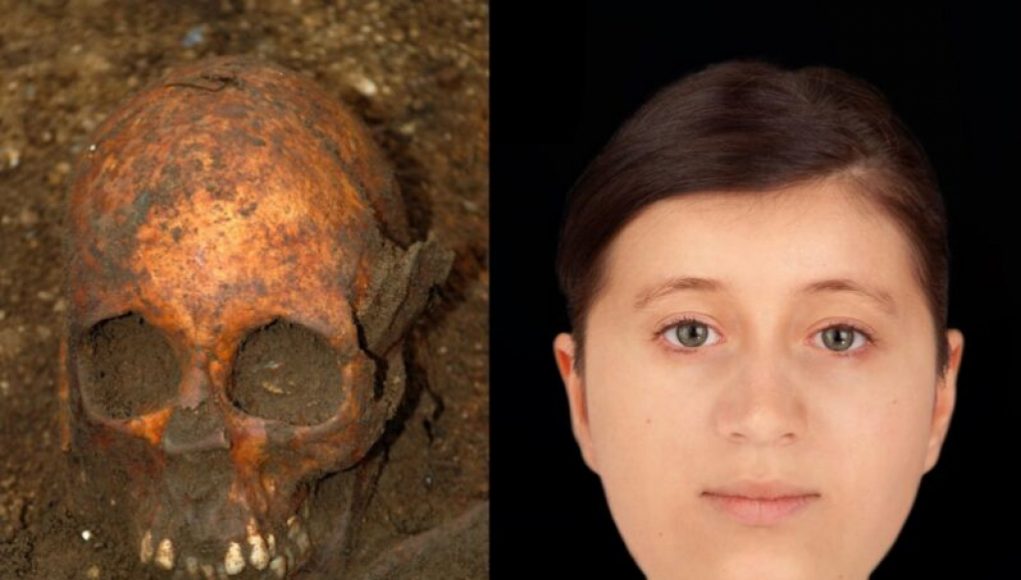Get ready to step back in time and discover the fascinating story of a seventh-century CE Anglo-Saxon teenage girl. Recently, archaeologists unveiled the facial reconstruction of her remains, which were found in a rare “bed burial” in 2012. You can see the reconstruction for yourself at the University of Cambridge’s Museum of Archaeology and Anthropology, as part of the new exhibit “Beneath Our Feet: Archaeology of the Cambridge Region.”
But that’s not all – scientists also analyzed the young woman’s bones and teeth to learn more about her diet and geographical region of origin. It’s believed that she was about 16 years old when she died, and her grave was discovered near a village called Trumpington just outside Cambridge. This particular burial is one of only 18 “bed burials” discovered thus far in the United Kingdom, a rare Anglo-Saxon practice usually reserved for high-status women.
The grave goods buried with the girl were an iron knife, a chatelaine (decorative belt), glass beads, gold and garnet pins, and most significantly, an ornate gold pectoral cross inlaid with garnets, now known as the Trumpington Cross. Archaeologists believe it may have been sewn onto the robe she wore when she died. Such crosses are very rare, and its presence indicated the young woman was likely a member of Anglo-Saxon nobility, particularly when combined with the evidence of the bed burial. The cross indicates she was a Christian, but the grave goods are a pagan practice, so archaeologists view the find as representative of a pivotal period in British history when Christianity had just begun to spread through the land.
To reconstruct the girl’s face, forensic artist Hew Morrison used measurements of the skull and general tissue depth data. The resulting face is notable for having a left eye slightly lower than the right, which Morrison believes “would have been quite noticeable in life.” Don’t miss your chance to see this incredible piece of history and learn more about the fascinating world of Anglo-Saxon culture.Check out these stunning archaeological finds from a bed burial in England! The Trumpington Cross, a 3.5 cm piece inlaid with garnets, and gold and garnet pins were discovered alongside the remains of a young woman. Isotopic analysis suggests that she moved to England from southern Germany at a young age and suffered from an illness towards the end of her life. Cambridge bioarchaeologist Sam Leggett speculates that she may have been part of an elite group of women who traveled from mainland Europe, but their purpose remains a mystery. What do you think?Get ready to step back in time and discover the fascinating story of the “Ipswich Lady”! This ancient woman’s remains were discovered in a burial chamber in Suffolk, England, and her well-preserved body has given us a glimpse into what life was like during the Iron Age. The upcoming exhibit at Cambridge University will showcase not only her remains, but also the stunning artifacts found with her, including the Trumpington Cross and gold and garnet pins. But that’s not all – visitors will also get to see pottery and textiles from a Bronze Age site known as “Britain’s Pompeii,” a carving of an Iron Age man, and even a recently discovered ivory belt buckle that belonged to a young Augustinian friar. Don’t miss out on this incredible opportunity to travel back in time and experience history like never before!
A remarkable revelation about the physical appearance of the Anglo-Saxon teenage girl has been made by Archaeologists. Scientists have uncovered the skeletal remains of a 7th century girl, seemingly 13 to 15 years old, who lived around the area of what is now the South Coast of England.
From detailed examination of the bones, it has been possible to reconstruct what the girl would have looked like whilst alive. The researchers observed that she was approximately 5’ 2” tall with a probably slim, muscular frame and fair skin. Notably, they inferred that she would’ve had light-coloured eyes, potentially grey, and blonde or brown hair.
Interestingly, the wooden shaft of a spear was found within her burial chamber. This has suggested that the girl was buried a woman of some societal significance, perhaps one with a military background and influence.
The discovery of the girl’s remains further broadens the comprehension of our understandings of the Anglo-Saxon society, particularly in terms of how individuals looked and their importance in that period.
The Anglo-Saxon teenage girl was found in a cemetery near Boscombe, UK which comprises 1,400 remains. High rates of cremation suggest that the area was a popular source of ritualistic practices between the 6th and 7th centuries.
Dr. Catriona Pickard, part of the research team, commented: “It’s fascinating to think that this girl probably lived in the area around Boscombe, perhaps in an Anglo-Saxon settlement, over 1,200 years ago.”
The girl is the most complete Anglo-Saxon juvenile skeleton found in Britain. The revelations made from her remains are vast and demonstrate the importance of the practice and further study of archaeological techniques to provide further evidence into ancient populations.




















